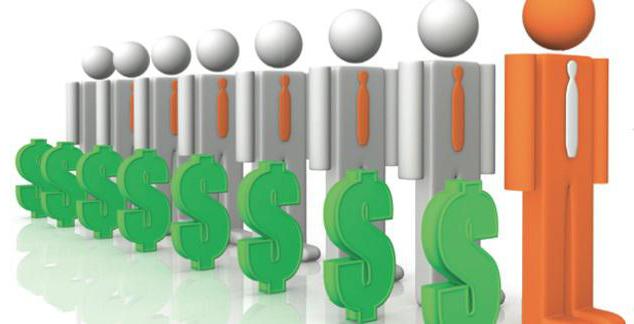The number of questions about the actual share when a participant leaves the organization has been huge lately. This indicates an increased interest in this issue, because it is he who often becomes the cause of corporate disputes. In this article, we will consider those issues that arise most often when assessing the share of an LLC participant who intends to leave the organization.
Withdrawal of a participant from the LLC with the payment of a share
Each founder of the organization has the right at any time, according to his personal desire, to leave the composition of the founders of the LLC. In accordance with Federal Law No. 26 “On LLC”, in order for such a participant’s exit to be obstructed, certain requirements must be observed. There are only two basic requirements:
1. The charter of an established LLC shall provide for the right to withdraw founders from its composition.
2. At the time of the participant’s withdrawal from the LLC, he should not be the only one. That is, after this founder leaves the organization, at least one more founder must remain in its composition. In this case, it is possible to sell the share of the sole shareholder of the LLC to a third party.
The founder may leave the company by notifying him of this by means of a free-form application. This statement confirms that the participant intends to leave the organization. In this case, the release date will be considered the moment when such a statement was received by the director of the organization, or the Board of Directors, or another authorized person of the company. But why do we need an estimate of the share of the LLC participant? More on this later.
Cases of exclusion from the founders
Also, the founder of an organization can be excluded from its founders in the following situations:
• If the co-founder has voted against the conclusion of a transaction of especially significant significance and after that the remaining members of the company have demanded his withdrawal.
• If the decision to expel the founder is made at the general meeting of the founders of this organization.
• If the founder has died. In this case, the payment of the share due to him may be required by his heirs.
There are other reasons as provided by law. At the same time, the organization is obliged to pay the share due, regardless of the reasons for which the founder left the founders of the organization. The organization is charged with such a duty from the moment the share of the exiting participant has passed to it. Also, the consent of the LLC participants to the sale of the share is required.
It is worth noting that the company does not have a legal right to pay the share due to the withdrawn participant if, at the time of exit, the company goes through the process of declaring it bankrupt. That is, in the event that it has signs of insolvency.
How is the appraisal of a stake in an LLC participant carried out? Let's figure it out.
Ways to exit the company and the process of distribution of shares
How is the process of state registration of the changes taking place?
In the event that one of its founders leaves the company, then there is a change in information about the organization, which is subject to registration. The obligation to submit changes to the relevant bodies is borne directly by the company itself, and not by the participant who has withdrawn from the LLC. More specifically, the company should transmit to the registration authorities information that there was a sale of a share of the LLC participant and its withdrawal from the company. This information should be submitted in the form of an application in the form of P14001.This obligation of the company is fixed in the legislation and is regulated by federal law No. 14, its article No. 31.1.
There are various ways out of the founder of the company and the subsequent distribution of its share. However, the organization is obliged to make a decision on how to dispose of the shares within only one year from the moment the participant leaves. If this does not happen, then the authorized capital of the organization should be reduced in proportion to this share. The calculation of the share of LLC participants should be made.
How can I manage my share?
The company may dispose of the share of the participant who left the LLC in several ways, for example:
- Carry out its distribution between the other participants, and in an amount proportional to their own shares.
- Carry out the sale of a share in the LLC to a participant (any) of the company.
- If the organization’s charter allows, it is possible to sell the share of the exiting participant to a third party who is not part of the LLC.
- Giving a share to a participant in an LLC.
Giving
Gift is the alienation of property. The share in the authorized capital of the LLC is transferred under a gift agreement, where one side is the founder or participant of the company, which carries out a free transfer. He will be the donor in this case. The other side is considered the donee, the new owner of part of the property.
The donor has the right to give his share to one participant of the LLC, and may even distribute it among the members of the company. To complete such a transaction, the consent of other participants is not required, however, the charter may provide for other rules.
A third party can be bestowed only in cases not prohibited by the charter of the LLC. But in frequent cases, the document nevertheless prescribes the mandatory consent of members of the company to such a donation of the charter share to a third party. This is done for the participants to use the pre-emptive right to purchase the part to be donated to a third party so that the new shareholder does not arise without the desire of the other founders of the LLC.
The gift agreement must be drawn up according to regulatory enactments, that is, in accordance with their requirements. Its validity is confirmed by an indication of specific subject and parties.
The mechanism for calculating the true value of a share
DSD, which belongs to the founder of the LLC, is that part of the assets that is proportional to the share itself. Such a definition of DSD is recorded in Article No. 23 of Law No. 14. In accordance with this definition, we can say that the formula for the calculation has the following form:
DSD = ChA / 100 * RDU;
that is, in order to calculate the DDD, it is necessary to divide the amount of net assets by one hundred and multiply by the size of the share owned by the founder.
Such a concept as net assets of an enterprise is a very important indicator characterizing the financial and economic stability of an organization in the market. The procedure for determining the NA is provided by law and recorded in the relevant regulatory acts. In accordance with this procedure, PAs are a delta that arises between the assets of enterprises and its liabilities. This is part of the procedure for assessing the share of an LLC participant.
Cha cost calculation
The mechanism by which the cost of private equity is calculated is provided by the Ministry of Finance, but only in relation to joint-stock companies. But taking into account the fact that the financial statements of LLC are formed according to similar principles, the established procedure is also applicable to LLC. The Ministry of Finance does not object to such a practice, which is enshrined in his official letter.
In accordance with the established procedure, the formula for calculating the NA has the following form:
PA = (total amount of the third section of the balance sheet) + (anticipated deferred income) - (debt owed by the founders in the form of contributions to the authorized capital).
It should be noted that the organization has no obligation to pay the cost of the share when the participant leaves the LLC, if the organization’s ChA are at a negative level.
In fact, the only document on the basis of which the DSD is calculated is the organization’s financial statements. The cost indicators, which are taken as the basis for calculating the DSD, should be taken from the balance sheet, or more precisely, from its corresponding lines.
Another calculation procedure
In addition, there is another order. It is based on the need to take into account the market value of the assets of the enterprise when calculating the size of the share of the LLC participant, which is withdrawing from the organization. This order often causes corporate disputes that affect the calculation of DSD.
In accordance with paragraph 16 of Resolution No. 90/14, a founder who leaves the LLC and who does not agree with the calculations in determining the value of his share has the full right to appeal the validity of such calculations by appeal to the arbitration court. However, it is important to understand that for such treatment it is necessary to have an appropriate evidence base. In this case, the court will consider the legality of the calculations that were made by the organization and will take the appropriate decision. In this case, the evidence base is determined by representatives of an independent expert examination.
Market share valuation
It is worthwhile to separately consider a different procedure for calculating DSD when the founder leaves the organization, which is based on taking into account the market value of the assets of the enterprise. This approach is reflected in the existing judicial practice, and this is confirmed by the relevant regulatory acts. The government believes that this approach, taking into account market value, is fully consistent with the principles of justice.
In other words, the value of the share of the LLC participant is the inventory value, which is reflected in the balance sheet of the enterprise. But when market value is taken into account, the organization’s assets are calculated based on their valuation in the corresponding market segment.
It is logical that the value of the assets of an enterprise, for example, its property, transport or land, may change over time. However, most enterprises, wanting to save money when paying property taxes, try not to display the real value of the assets they own, for example, the value of real estate listed on the balance sheet of the enterprise. In the event that the balance sheet distorted reflects the real value of fixed assets, this will undoubtedly negatively affect the founders who are leaving the LLC and their interests.
Legislative accounting provisions require that the financial statements of an entity conduct business activities that contain reliable information about its financial position. If this requirement is met, the value of the assets on the balance sheet will fully correspond to their value in the market.
Actions upon discontent of a participant
It is important for organizations to understand that a participant dissatisfied with an assessment of a stake in an LLC has the full right, enshrined in law, to appeal to the courts with a requirement to recalculate the DSD taking into account the market value of the assets of his organization. And in this case, there is a great chance that he will win the case. Therefore, if the founder leaving the organization requires payment of a share calculated taking into account market value, it is better to meet him and recalculate. That is, you should not wait for a court decision, which enforces the obligation to make this kind of payment. This will avoid additional costs associated with litigation.In addition, if the founder, who leaves the organization, disputes DSD and receives a positive court decision, he will also receive the right to file a claim for interest that the company received through the unlawful use of other people's finances. This right is regulated by the eighteenth paragraph of Resolution No. 90/14.
Payment of a share to a LLC participant
Another reason that may cause a corporate dispute is the DSD of the assets of the enterprise, which are not reflected on the balance sheet of this enterprise, but are owned and used in the course of its business activities. Such situations are also provided for by law and enshrined in relevant regulations. In accordance with the opinion of the arbitral tribunal, if an enterprise uses property and makes profit from such use, when calculating the DSD of a founder who leaves the LLC, the market value of such assets not included in the balance sheet should also be taken into account. The evidence base, confirming the market value of such assets, as mentioned earlier, is the opinion of an expert who conducts an independent examination by court decision.
It is worth noting that even with the involvement of an independent expert and making calculations based on his estimates, the possibility of disputes cannot be ruled out. Even in this case, the interested party has the right to challenge the results of the examination.
The occurrence of a reverse situation is not excluded. Suppose an asset in an illiquid state is listed on the balance sheet of an enterprise, the market value of which, according to expert estimates, is incredibly high. Thus, the company may be on the verge of bankruptcy after the payment of the share to the participant LLC of its current market value.
Such a discrepancy in the legislation may in some cases be beneficial to third parties who intend to take over the enterprise. This practice is called raider capture. In the same way, the elimination of a competing enterprise is possible.
To summarize all the above information, it is important to note that when registering an LLC, it is better to initially regulate such issues and reflect them in the charter of the enterprise. In the absence of a legislatively established procedure for calculating the DSD of the leaving founder, taking into account market value, based on an independent examination, the charter should reflect:
• procedure for calculating DSD;
• the time period during which the share is to be paid;
• periods to be used in calculating the DSD.
This will allow in the future to avoid many corporate disputes and conflict situations.
We reviewed the donation and sale of the LLC share to a member of the company upon exit. We hope this information is helpful.



